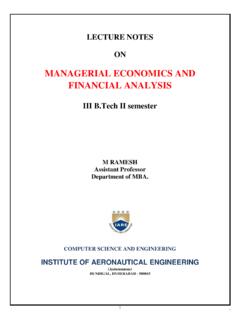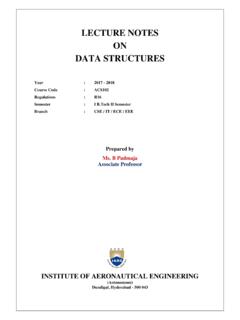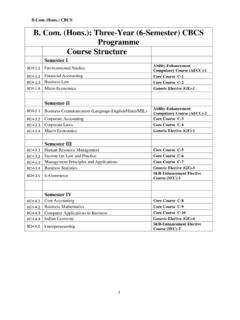Transcription of SECURITY ANALYSIS AND PORTFOLIO MANAGEMENT
1 LECTURE NOTES ON SECURITY ANALYSIS AND PORTFOLIO MANAGEMENT MBA III semester R 16 syllabus M RAMESH Assistant Professor MASTER OF BUSINESS ADMINISTRATION INSTITUTE OF AERONAUTICAL ENGINEERING (Autonomous) DUNDIGAL- 500 043, HYDERABAD SYLLABUS UNIT-I INVESTMENT AND SECURITY ANALYSIS Investment environment in India, overview of Indian financial system securities trading in stock markets, investment alternatives, the investment MANAGEMENT process, SECURITY ANALYSIS : fundamental ANALYSIS , technical ANALYSIS , efficient market hypothesis.
2 UNIT-II PORTFOLIO ANALYSIS The returns and risks from investing Markowitz PORTFOLIO theory, mean variance approach, PORTFOLIO selection-efficient portfolios, the single index model capital asset pricing model, arbitrage pricing theory. UNIT-III BOND ANALYSIS & VALUATION & MANAGEMENT Types of bonds, interest rates, term structure of interest rates, measuring bond yields, yield to maturity, yield to call, yield to maturity, holding period return, bond pricing theorems, bond duration, active and passive bond MANAGEMENT strategies, bond immunization, bond volatility, bond convexity.
3 UNIT-IV EQUITY VALUATION & DERIVATIVES Equity ANALYSIS & valuation, balance sheet ANALYSIS equity valuation models, intrinsic value & market price, the p/e ratio & earnings multiplier approach, price/book value, price/ sales ratio, economic value added , overview of derivatives markets, option markets, option strategies and option valuation forward & future markets, strategies. Stock index futures, interest rate futures, swaps contracts. UNIT-V MUTUAL FUNDS Types of mutual funds schemes, structure, net asset value, risk and return, performance evaluation models Sharpe model, trey nor model, Jensen model, fame s decomposition.
4 Trends in Indian mutual funds. Text Books: 1. William. , Gordon j Alexander & Jeffery V Bailey, "Fundamentals of Investments", Prentice Hall 2. Reilly, Brown, " ANALYSIS of Investment and MANAGEMENT of Portfolios", 10th Edition, Cengage, 2012. Unit-I INVESTMENTS AND SECURITY ANALYSIS Introduction: SECURITY ANALYSIS is a pre-requisite for making investments. In the present day financial markets, investment has become complicated. Investment may be defined as an activity that commits funds in any financial /physical form in the present with an expectation of receiving additional return in the future.
5 Types of investments Investments may be classified as financial investments or economic investments. In the financial sense, investment is the commitment of funds to derive future income in the form of interest, dividend, premium, pension benefits, or appreciation in the value of the initial investment. Economic investments are undertaken with an expectation of increasing the current economy s capital stock that consists of goods and services. Objectives The main objective of an investment process is to minimize risk while simultaneously maximizing the expected returns from the investment and assuring safety and liquidity of the invested assets.
6 Investment Vs Speculation The capacity to bear risk distinguishes an investor from a speculator. An investor prefers low risk investments, whereas a speculator is prepared to take higher risks for higher returns. speculation is associated with buying low and selling high with the hope of making large capital gains. Investors are careful while selecting securities for trading. Investments, in most instances, expect an income in addition to the capital gains that may accrue when the securities are traded in the market . Investment is long term in nature. An investor commits funds for a longer period in the expectation of holding period gains.
7 However, a speculator trades frequently; hence, the holding period of securities is very short. Investment Vs Gambling Investment can also to be distinguished from gambling. Examples of gambling are horse race, card games, lotteries, and so on. Gambling involves high risk not only for high returns but also for the associated excitement. Gambling is unplanned and unscientific, without the knowledge of the nature of the risk involved. It is surrounded by uncertainty and a gambling decision is taken on unfounded market tips and rumors. In gambling, artificial and unnecessary risks are Created for increasing the returns.
8 Investment is an attempt to carefully plan, evaluate, and allocate funds to various investment outlets that offer safety of principal and expected returns over a long period of time. Hence, gambling is quite the opposite of investment even though the stock market has been euphemistically referred to as a gambling den . Investment environment Investment environment can be defined as the existing investment vehicles in the market available for investor and the places for transactions with these investment vehicles. Thus further in this subchapter the main types of investment vehicles and the types of financial markets will be presented and described.
9 Investment vehicles As it was presented in , in this course we are focused to the financial investments that mean the object will be financial assets and the marketable securities in particular. But even if further in this course only the investments in financial assets are discussed, for deeper understanding the specifics of financial assets comparison of some important characteristics of investment in this type of assets with the investment in physical assets is presented. Investment in financial assets differs from investment in physical assets in those important aspects: financial assets are divisible, whereas most physical assets are not.
10 An asset is divisible if investor can buy or sell small portion of it. In case of financial assets it means, that investor, for example, can buy or sell a small fraction of the whole company as investment object buying or selling a number of common stocks. Marketability (or Liquidity) is a characteristic of financial assets that is not shared by physical assets, which usually have low liquidity. Marketability (or liquidity) reflects the feasibility of converting of the asset into cash quickly and without affecting its price significantly.











